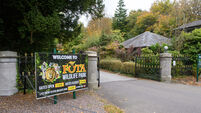Capital resplendent as Dublin’s denizens remember Rising

Sackville Street in Dublin looked resplendent as ladies donned the latest gowns and gentlemen their bowler hats to parade graciously in glorious sunshine.
The pity of it was that the naval hero Admiral Lord Nelson, who had stood sentinel over the city’s main thoroughfare since 1808, was not there to watch over these latter-day pillars of the community in all their gay and colourful splendour.













